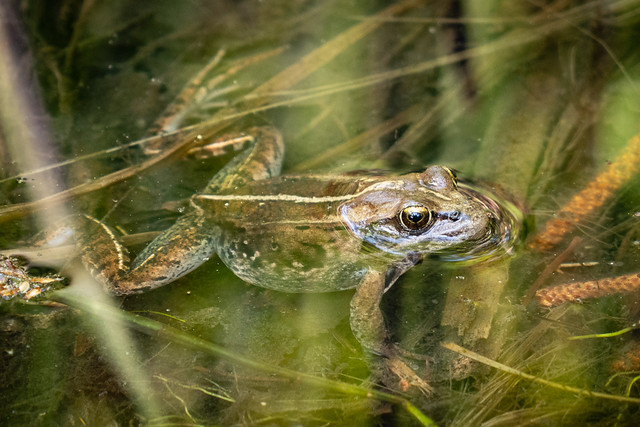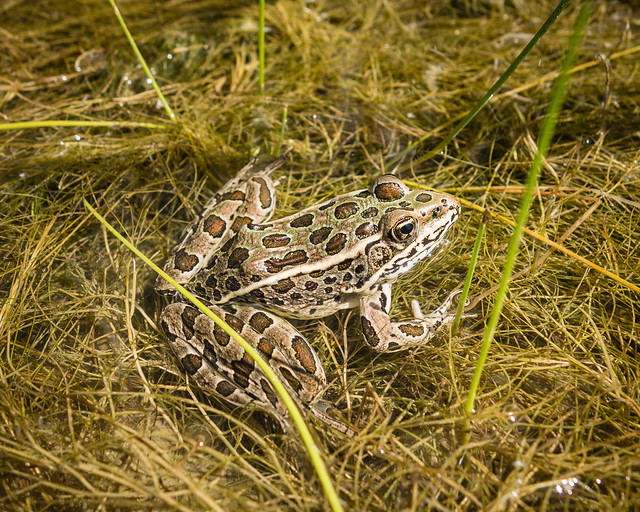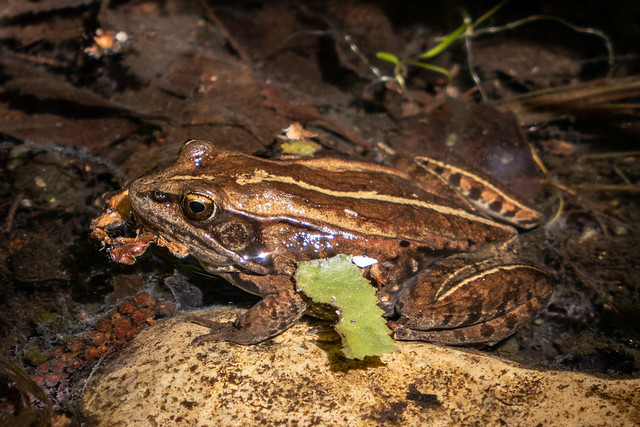Thursday, 30 April 2020
Saskatchewan's Frogs and Toads
There are 6 species of frogs and toads in Saskatchewan.
Boreal Chorus Frog
Boreal Chorus Frog are hard to see but easy to hear, especially in early spring when the males sing day and night to attract females and to defend their territory. The chorus of high-pitched trills has been compared to a fingernail running along the edge of a plastic comb.
Boreal Chorus Frog are small (just under 4 cm), smooth-skinned frogs. They are grey-green to brown with 3 dark stripes down their back, a dark stripe through their eyes, and a white stripe along their upper lip. They’re usually found in small, shallow, fish-free ponds surrounded by short, grassy vegetation in both prairie and forest settings.
The females lay their eggs in clusters, and they hatch in 1-4 weeks. The tadpoles turn into frogs after about 2 months.
Boreal Chorus Frog can be found from British Columbia to Quebec and up into the Yukon and the Northwest Territories as well as in the central United States as far south as Arizona. In winter, they try to find a mammal burrow or other underground cave below the frost line where they can safely hibernate.
Northern Leopard Frog
Northern Leopard Frog owe their name to the dark round spots on their green and brown back and legs. Prominent light-coloured folds of skin run down either side of their back, and they have a white belly. They are a medium-large frog, up to 11 cm in length.
Northern Leopard Frog are found near ponds and marshes across Canada and in most parts of the United States. They can be found as far north as Great Slave Lake and in the mountains. They are also known as Meadow or Grass Frog because they sometimes hop up onto lawns and golf courses in the summer when they've finished breeding.
Northern Leopard Frog will eat anything they can fit in their mouth and have been known to eat small birds and snakes. They sit still, wait for their prey, and then leap and grab it with their long, sticky tongue.
Wood Frog
Wood Frog are reddish-brown, medium-sized (3-8 cm long) frogs with prominent ridges on their back, a black mask over their eyes, and a white belly. Some have a white stripe down their back. They can change colour very rapidly, turning dark when cold to absorb more heat.
Wood Frog are found in every province and territory of Canada as well as the northeastern and central United States. They are the only frog found north of the Arctic Circle and are one of the few frogs found in Alaska. They prefer moist woodland areas and hibernate under the leaf litter covering the forest floor.
Like several northern frogs, including the Boreal Chorus Frog, Wood Frog tolerate below-zero temperatures by increasing the amount of glucose in their blood, which lowers the freezing point and stops ice crystals from forming.
Male Wood Frogs announce the start of the early spring breeding season with small clucking sounds. Over a short 1-2 week period, the frogs will mate and the females will each attach up to 2,000 eggs to underwater vegetation. The tadpoles eat plants, while the adults use their long, sticky tongue to capture insects, spiders, slugs, worms, and snails.
Canadian Toad
Canadian Toad are found in river valleys and around lakes in the grasslands, aspen parklands, and boreal forest of the Canadian prairies and south to the Dakotas and Minnesota. They’re medium-sized (up to 9 cm) and grey-green to brown with brownish-red warts. Unlike the Great Plains Toad, they have grey spots on their light-coloured belly and the raised ridges on their head join to form a bump between their eyes.
Canadian Toad are easiest to spot in the spring when they congregate at breeding ponds. The males call to the females with a high-pitched trill that repeats every 15-20 seconds. Once breeding season is over, the toads spread out into the grasslands and aspen parklands, although they generally stay close to water. Their mottled earthy colors are good camouflage.
Canadian Toad hibernate underground below the frost line in burrows they've dug using the bony lumps on their rear legs.
Great Plains Toad
Great Plains Toad are medium-large (up to 11 cm), ranging in colour from pale brown-grey to olive, with dark blotches and numerous small warts. Unlike the Canadian Toad that share the same habitat, Great Plains Toad have a solid white belly and the L-shaped ridges around each eye fuse in a V rather than a lump between the eyes.
Great Plains Toad can be found in the grasslands of southern Alberta, Saskatchewan, and Manitoba and south into the central plains of the United States. They breed in temporary pools, ditches, and dugouts, laying long strings of up to 20,000 eggs. The eggs hatch in about 2 days and the tadpoles turn into frogs after 6 weeks.
Great Plains Toad hibernate in underground burrows from October to April. They are more active at night and escape the heat of the day by digging shallow burrows in loose soil. During a severe drought, they can remain inactive underground for extended periods of time.
Great Plains Toad have large home ranges and can travel over a kilometer between breeding sites, summer habitats, and hibernation sites. When threatened, they puff themselves up with air, lift themselves up on all 4 legs, and lower their head. Poisonous secretions in their warts and the large glands behind their eyes help to deter predators.
Plains Spadefoot Toad
Plains Spadefoot Toad can be found on short-grass prairie from southern Alberta, Saskatchewan, and Manitoba south through the central plains to New Mexico, Oklahoma, and West Texas. They have a round body (up to 6.5 cm), short legs, a bony lump between the eyes, and a vertical pupil. They are tan to dark brown with small orange/yellow spots and a white belly. They often have 4 white stripes down their back.
Plains Spadefoot look like a frog. Unlike the Canadian Toad and the Great Plains Toad, their skin is relatively smooth and moist. They have a vertical rather than a horizontal pupil and lack the large parotoid glands behind the eyes.
Plains Spadefoot are hard to spot as they are nocturnal and spend much of their time buried in the sand to conserve moisture. They come out at night to hunt for beetles, crickets, and grasshoppers. Plains Spadefoot tunnel backwards using the sharp knobs (or spades) on their hind feet. Their tunnels can extend as much as 1 meter – no wonder they prefer sandy or gravel soil that is easier to dig.
See Also
10 Surprising Facts about Frogs and Toads
Saskatchewan’s Snakes
Nature Companion, a Comprehensive Nature App for Canada's four Western Provinces
You can follow EcoFriendly Sask by liking us on Facebook, following us on Twitter, or by email (top right corner).



